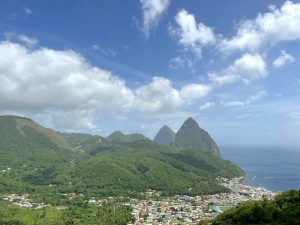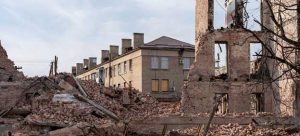
Aerial view of the town of Soufriere in the south of Saint Lucia. Sea level rise is threatening coastal areas of small island developing states (SIDS) in the Caribbean. Credit: Alison Kentish/IPS
By Alison Kentish
SOUFRIERE, SAINT LUCIA, Jul 7 2023 – The World Meteorological Organization says adaptation efforts and the switch to renewable energy must increase for regions like Latin America and the Caribbean to face the challenges of a changing climate.
The United Nations Weather Agency released its State of the Climate in Latin America and the Caribbean 2022 report this week.
It states that storms, rainfall and flooding in some areas, along with severe drought in others, resulted in hundreds of billions of dollars in economic losses and placed a ‘significant’ burden on human lives and wellbeing throughout the reporting period.
It adds that North and South Atlantic sea levels rose at a higher rate than the global average – threatening coastal areas of several Latin American countries and small island developing states (SIDS) in the Caribbean.
While the 2022 Atlantic hurricane season recorded 14 named storms, a near-average number, nine of those cyclones affected land areas, with Fiona and Ian becoming major hurricanes. Hurricane Fiona led to 22 deaths and caused an estimated US$2.5 billion in damage across Puerto Rico, making it the third costliest hurricane on record there. Hurricane Ian drenched Jamaica with 1,500 mm of rainfall that impacted local communities before striking Cuba as a category 3 storm which destroyed over 20,000 hectares of land for food production.
According to the report, temperatures have increased by an average of 0.2 degrees Celsius per decade over the past 30 years, which represents the highest spike since records began.
“Many of the extreme events were influenced by the long-running La Niña but also bore the hallmark of human-induced climate change. The newly arrived El Niño will turn up the heat and bring with it more extreme weather,” said WMO Secretary-General Petteri Taalas.
The second most disaster-prone region in the world, Latin America and the Caribbean must now bolster climate change adaptation and mitigation measures, particularly in agriculture, food security and energy. This is also where Early Warning Systems (EWS) come in.
“There are major gaps in the weather and climate observing networks, especially in the least developed countries (LDCs) and small island developing States (SIDS); these gaps represent an obstacle to effective climate monitoring, especially at the regional and national scales, and to the provision of early warnings and adequate climate services. Early warnings are fundamental for anticipating and reducing the impacts of extreme events,” Taalas said in the foreword to the 2022 report.
The WMO is leading the United Nations Early Warnings for All initiative and its Executive Action Plan launched by United Nations Secretary-General António Guterres during the World Leaders Summit at the 2022 Climate Change Conference, COP27. The Action Plan aims to protect everyone on earth with early warning systems within five years.
“Only half of our members have proper early warning services in place,” said Taalas. “In order to more efficiently adapt to the consequences of climate change and the resulting increase in the intensity and frequency of many extreme weather and climate events, the Latin American and Caribbean population must be made more aware of climate-related risks, and early warning systems in the region must employ improved multidisciplinary mechanisms.”
According to the report, multi-hazard early warning systems (MHEWS) with the ability to warn of one or more hazards increase the efficiency and consistency of warnings through coordinated and compatible mechanisms. It adds that the Latin America and Caribbean Region experiences considerable early warning challenges. For example, in South America, only 60% of people are covered by these systems.
Over 15 research organizations and 60 scientists contributed to the 2022 report. They are calling for widespread education campaigns on the deadly risks of climate-related disasters and to reinforce public perceptions of the need to react to natural hazard alerts and warnings issued by national institutions.
“The ultimate goal is to ensure that responsibilities, roles and behaviours are well described and made known to everyone involved in the identification and analysis of risks related to weather, water and climate extremes and the early warning providers and recipients.”
This is the WMO’s third annual report, and its release coincided with the hottest day on earth.
With the confirmation that extreme weather and climate shocks are becoming more acute in Latin America and the Caribbean, coupled with global warming and sea level rise, the organization says multi-hazard early warning systems are needed to improve anticipatory action.
IPS UN Bureau Report




![A view of the Canoas Wind Farm, owned by Neoenergia, the Brazilian [...] <a class=](https://www.ipsnews.net/Library/2023/07/a-3-300x225.jpg) Read more »
Read more »